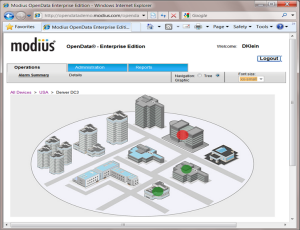Enterprise software Proof-of-Concepts (POCs) are often challenging to administer and implement as they typically require the vendor to train, install and implement the software in the client’s facility. This process can prove costly and time consuming for both the vendor and the client.

Modius has solved this challenge by creating a new offering for a “virtual” proof of concept (vPOC). The vPOC allows customers to try Modius OpenData in a secure sandbox environment without installing any local software.
The database is pre-populated with a typical Data Center environment including a full range of data center equipment, including typical ‘heavy equipment’ such as UPS, CRAC, Genset, PDU, as well as rack-level equipment such as iPDU’s and wireless temperature sensors from leading equipment providers including HP, IBM, APC, Emerson, RFCODE, and Server Tech.
The vPOC provides a fully -functional instance of the Modius OpenData system that the user can manage and administer. The Graphical User Interface (GUI) allows the user to drill through to each device and identify which alarm points are being collected, how they are correlated and distributed, their polling rates, and which “real-time” alarms are critical or require immediate action. Typical customers who are signing up for a Modius vPOC are looking to replace several existing monitoring point solutions (e.g. homegrown, ALC or DataTrax). In addition, they may be looking at Modius OpenData’s “multi-site” capability to consolidate existing infrastructure monitoring across multiple locations with a single repository of easy accessed and reported information for availability, capacity, and performance utilization.
-functional instance of the Modius OpenData system that the user can manage and administer. The Graphical User Interface (GUI) allows the user to drill through to each device and identify which alarm points are being collected, how they are correlated and distributed, their polling rates, and which “real-time” alarms are critical or require immediate action. Typical customers who are signing up for a Modius vPOC are looking to replace several existing monitoring point solutions (e.g. homegrown, ALC or DataTrax). In addition, they may be looking at Modius OpenData’s “multi-site” capability to consolidate existing infrastructure monitoring across multiple locations with a single repository of easy accessed and reported information for availability, capacity, and performance utilization.
The process to get started is as simple as signing up for the 15-Day free trial. To get started, please see our vPOC registration page for a simple form to have one of our team contact you.

